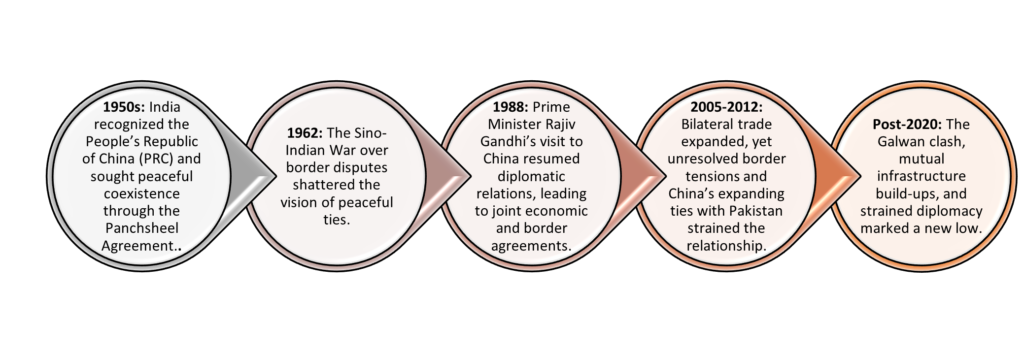(General Studies II – International Relations Section –India and its Neighborhood- Relations)
- India-China relations are a blend of shared histories and complex rivalries, deeply affected by political, territorial, and cultural factors. While some leaders view diplomacy as essential to stability, tensions are never far from the surface.
- As Chinese Premier Deng Xiaoping noted, “China and India can work together to make the Asian Century a reality.” Yet, recent issues highlight the fragile state of cooperation, revealing deep-seated strategic mistrust.
Recent Issues in India-China Relations:
- Border Disputes and the Galwan Clash: The 2020 Galwan Valley clash marked a significant shift, resulting in casualties on both sides and heightened military tensions along the Line of Actual Control (LAC). Since then, “the shadow of Galwan” has hung over all diplomatic engagements, impacting trust at all levels.
- China’s Relationship with Pakistan: China’s strong ties with Pakistan, particularly via the China-Pakistan Economic Corridor (CPEC), further strain relations. Since parts of the CPEC pass through Pakistan-occupied Kashmir, India sees these investments as a challenge to its sovereignty.
- Dalai Lama and Tibet: The Dalai Lama’s presence in India remains a deeply sensitive issue for China. India’s grant of asylum to the Dalai Lama and Tibetan exiles has long irked Beijing, which regards him as a separatist figure. India’s cautious engagement on Tibet reflects its need to balance humanitarian support with diplomatic caution. Chinese officials regularly cite this as “interference in China’s internal affairs,” but India maintains it as a stance on humanitarian grounds.
- Economic Competition and Trade Imbalance: The trade imbalance, heavily favoring China, is another critical issue, with India’s trade deficit reaching approximately $70 billion in recent years. India has since implemented restrictions on Chinese investments and banned several Chinese apps, underscoring its drive for economic self-reliance.
- Regional Influence and Quad Engagement: India’s involvement in the Quadrilateral Security Dialogue (Quad) alongside the U.S., Japan, and Australia reflects its efforts to counterbalance China’s regional dominance. While Quad nations emphasize it as a cooperative security arrangement, China views it as a containment strategy.
Historical Background and Key Milestones:

Key Points of Friction:
- Border Issues: Persistent conflicts along the LAC, with China’s infrastructural expansions, continue to escalate tensions.
- Economic Imbalance: China remains India’s largest trading partner, but the trade deficit undermines economic trust.
- The Tibet Issue: India’s asylum to the Dalai Lama and its cultural support for Tibetan exiles strain diplomatic ties.
- China’s Indo-Pacific Strategy: Beijing’s Belt and Road Initiative (BRI) and activities in the Indian Ocean raise India’s security concerns.
- Military Modernization: Both nations are advancing military assets along the border, making de-escalation complex.
Recent Measures by India:
To mitigate these challenges, India has adopted a balanced approach that incorporates resilience, security, and diplomacy:
- Infrastructure Development: India is accelerating border road construction and establishing forward bases along the LAC to enhance response capabilities.
- Economic Self-Reliance: India’s “Atmanirbhar Bharat” initiative promotes self-reliance, aiming to reduce dependency on Chinese imports, particularly in technology and manufacturing.
- Strengthening Alliances: Through Quad engagements and defense pacts, India has intensified partnerships with countries in the Indo-Pacific region to counterbalance China’s influence.
- Military Readiness: Enhanced budget allocations and procurement of advanced military assets reflect India’s commitment to border security.

India-China relations stand at a crossroads, defined by competition, interdependence, and diplomatic prudence. While both countries face incentives to avoid conflict due to economic interdependence and regional stability, sustainable progress depends on mutual respect for sovereignty and constructive engagement on contentious issues. As regional players and global economies, their relationship will profoundly shape the trajectory of Asia’s future.

